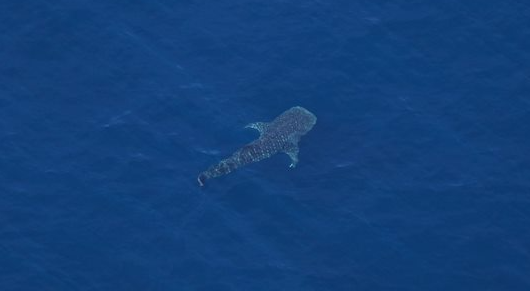Please note: We strongly recommend purchasing tickets online in advance to guarantee entry, as we do sell out on weekends.
Summer aerial survey marks five years of the Aquarium’s research in monument

BOSTON, MASS. (Aug. 23, 2022) – In a summer when numerous humpback whales have captivated onlookers from nearby shorelines, New England Aquarium researchers flew further offshore last week, traveling 130 miles to the federally-protected Northeast Canyons and Seamounts Marine National Monument and spotted more than 500 diverse marine animals including dolphins, sharks, whales, and rays during its summer aerial survey.
LINK TO HIGH RES IMAGES OF SPECIES SPOTTED IN AERIAL SURVEY (Please credit NEW ENGLAND AQUARIUM)
In a few short hours on August 14, the team saw from an airplane above: 24 Atlantic spotted dolphins, one blue shark, 86 bottlenose dolphins, 21 Chilean devil rays, two fin whales, 169 Risso’s dolphins, 86 hammerhead sharks, 10 ocean sunfish (Mola mola), 15 pilot whales, 16 common dolphins, 75 striped dolphins, two tiger sharks, four unidentified beaked whales, and one whale shark.
The Monument is located 130 miles southeast of Cape Cod, a protected habitat with four underwater seamounts, or underwater mountains, and three deep sea canyons, where a vast array of species feed and frolic, making it a stunning display of species diversity. This is the 12th aerial survey by the Aquarium team to the distant Monument. Over the past five years, these surveys have documented a number of interesting species, including blue whales, beaked whales, and whale sharks. After observing the high number of marine animals, Aquarium researchers published a study earlier this year in Conservation Science and Practice that used over 180,000 sightings from U.S. East Coast waters and showed that the Monument protects a diverse and unique marine mammal community.
“While we delight in the offshore species we get to observe in the Monument, the impossibly blue water provides a stunning background to photograph old friends, as well,” said one of the researchers, Sharon Hsu, in a blog for the Aquarium. “The calm winds made the water appear almost glassy; we watched a small group of common dolphins meander past a shark, and a large pod of bottlenose dolphins escort their tiny calves through the water.”
The 5,000-square-mile Monument is a hotspot of biodiversity on the edge of the continental shelf where the shallow seas off New England drop sharply into the deep waters of the northwestern Atlantic. In 2016, President Obama designated this area as the first, and only, Marine National Monument in U.S. Atlantic waters. In June 2020, President Trump signed a proclamation lifting the prohibition of commercial fishing. A study by the Aquarium that used the aerial survey and other data sets showed that opening the Monument to commercial fishing as allowed under U.S. law would increase the risk of entanglement, bycatch, and habitat destruction for species from the sea surface to sea floor. President Biden restored the Monument’s protections when he took office in January 2021.
The New England Aquarium and Mystic Aquarium played a crucial role in the designation of the Monument. The aquariums provided strong scientific evidence about this diverse habitat in cold, nutrient-rich waters that supports deep-sea corals and offers food and shelter to sea birds and other endangered and threatened marine species including sea turtles, sharks, and whales. Ongoing aerial surveys continue to document the monument’s high biodiversity and environmental significance.
Currently, only 3% of U.S. waters are fully protected. As the nation aims to protect 30% of U.S. waters by 2030, outlined in the goals articulated in the Biden-Harris Administration’s “Conserving and Restoring America the Beautiful” report, the New England Aquarium supports the need for more effective marine protected areas that are equitable, representative of marine biodiversity and regions, and bring significant conservation benefits.
“As marine-life enthusiasts and researchers, our team is immensely grateful to have the opportunity to conduct these surveys and continue research needed to support the protection of the Monument and other marine areas,” Hsu wrote in the blog.
MEDIA CONTACT:
Pam Bechtold Snyder – psnyder@neaq.org, 617-686-5068
